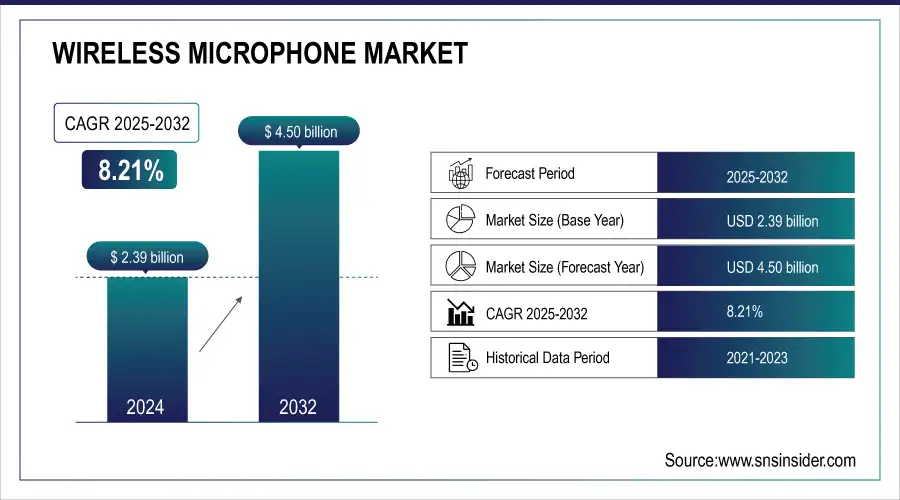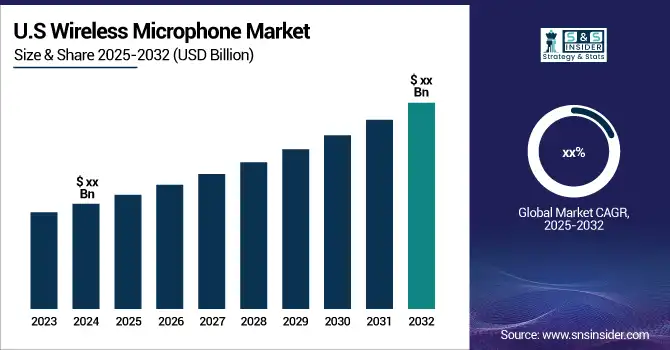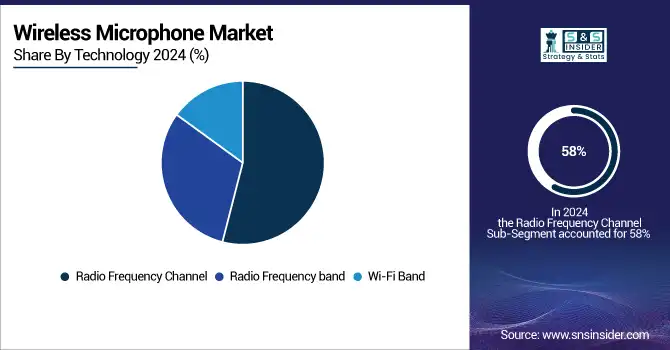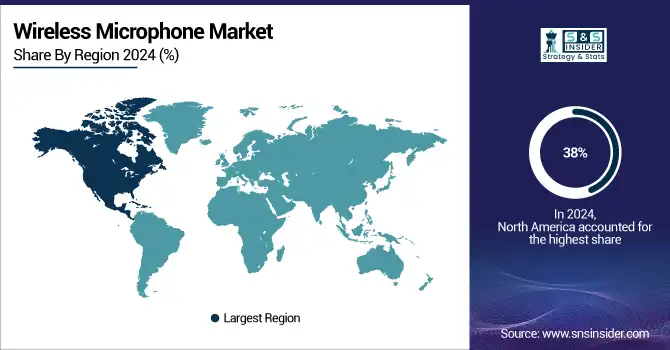Wireless Microphone Market Report Scope & Overview:
Wireless Microphone Market was valued at USD 2.64 billion in 2025E and is expected to reach USD 4.96 billion by 2033, growing at a CAGR of 8.21% from 2026-2033.

Get More Information on Wireless Microphone Market - Request Sample Report
The wireless microphone market is rapidly growing due to its adoption across entertainment, sports, education, corporate, and public events. Its convenience, mobility, and improved sound quality drive demand, especially with Bluetooth, Wi-Fi, and hybrid models. Education and corporate sectors increasingly rely on wireless microphones for clear communication. Rising use of UHF/VHF systems, portable designs for content creators, and live performances in entertainment boost growth.

Wireless Microphone Market Size and Forecast
-
Market Size in 2025E: USD 2.64 Billion
-
Market Size by 2033: USD 4.96 Billion
-
CAGR: 8.21% from 2026 to 2033
-
Base Year: 2025E
-
Forecast Period: 2026–2033
-
Historical Data: 2022–2024
Wireless Microphone Market Trends
-
Rising demand for live events, broadcasting, and entertainment is driving wireless microphone adoption.
-
Advancements in digital transmission, noise reduction, and signal stability are improving performance.
-
Growing use in corporate, education, and streaming applications is expanding market reach.
-
Integration with Bluetooth, RF, and multi-channel systems is enhancing flexibility and user experience.
-
Increasing preference for portable and easy-to-use audio solutions is boosting adoption.
-
Expansion of e-commerce and rental services is improving accessibility for professionals and hobbyists.
-
Collaborations between audio equipment manufacturers and tech companies are accelerating innovation and feature development.
Wireless Microphone Market Growth Drivers:
-
Integration of Bluetooth, Wi-Fi, and digital systems enhances connectivity, encryption, and sound quality.
The integration of Bluetooth, Wi-Fi, and digital systems significantly increased the efficiency and range of applications of wireless microphones. In particular, the use of Bluetooth eased the process of connecting the microphone to a variety of devices, such as smartphones, tablets, and laptops, allowing users to quickly find and pair their devices with the microphone. As such, this type of microphone was most frequently used by content creators, educators, and other specialists seeking to lighten their technological load with convenient solutions. However, the integration of Wi-Fi further improved the parameters of microphones as applied in larger spaces and in areas with a greater number of devices.
Wireless Microphone Market Restraints:
-
Advanced models with sophisticated features may require technical expertise, deterring non-technical users.
Top-of-the-line wireless mic products that come with more advanced features, such as multi-channel operation, on-board processing, or Bluetooth or Wi-Fi capabilities, sometimes become more complex than a sound technician who is not technologically inclined would feel comfortable handling effectively. Although these attract numerous advantages in terms of performance, they also bring some complexities in the developing and deploying part of the task. For example, setting parameters on how to prevent interference at certain frequencies, or handling digital encryption protocols may be perplexing to non-technical users who are not familiar with the process. This complexity can also lead to inhibiting adoption, especially for individual users and small businesses, or organizations with little technical backup.
Wireless Microphone Market Segment Analysis
By Technology, Radio frequency channel segment dominated in 2025 with 58% share, Radio frequency band segment is expected to grow fastest.
In 2025, The radio frequency channel segment dominated the market and accounted for the largest share with 58% of the global remote radio head market. Interrogation using the radio frequency channel allows for more channel options as it is application-dependent. Furthermore, adapting spectrum regulations has allowed these products to utilize RF bands for effective signal transmission.
The radio frequency band segment is anticipated to be the fastest-growing segment from 2026 to 2033. With the use of multichannel radio frequency equipment, it can switch frequency regardless of the strength of the transmission provide a more reliable broadcasting operation, and save from losing signal. The 600 MHz frequency band has been reduced in size due to various regulatory mandates, thereby increasing the use of other frequency bands for RF signal transmission applications, including the 721 MHz - 750 MHz frequency band.

By Product, Handheld segment dominated in 2025 with 49% revenue share, Clip-on segment is expected to grow fastest.
In 2025, the handheld segment dominated the market and held the highest revenue share of 49% in the wireless microphone market Based on their reliability and lower costs as compared to other products, handheld devices are being used for many applications
The clip-on segment is likely to be the fastest-growing segment during the forecast period. Clip-on microphones are handy and enable portability, which is why they are expected to grow at the highest CAGR during the forecast period. In addition to that, These devices can allow you to keep your hands free while you are delivering a speech or at public events. Increasing demand for clip-on devices is anticipated to grow with increasing public speaking events.
By End-Use, Corporate segment dominated in 2025, Sporting events segment is expected to grow fastest.
The Corporate segment dominated the market and captured a significant revenue share in 2025. The increasing demand for wireless communication equipment has made its way to corporate enterprises. This trend can also be seen in developing regions like Asia Pacific and Latin America, where companies are going global hence, they have to use these products to be able to communicate internally and externally using these products.
The sporting events segment is expected to register the fastest CAGR during the forecast period. Sport events expansion has fuelled the growth of microphone products for announcement, commentary, and speech usage.
Wireless Microphone Market Regional Analysis
North America Wireless Microphone Market Insights
North America dominated the market and accounted for a revenue share of more than 38% in 2025, closely followed by Europe in part due to the existence of industry giants like Shure Incorporated and Sennheiser Electronic GmbH & Co. in the region. In addition, the North American region holds the largest share of the industry in terms of revenue, as the products launched by industry players get adopted by the local market first.

Need any customization research on Wireless Microphone Market - Enquiry Now
Asia Pacific Wireless Microphone Market Insights
The rapidly growing regional market is Asia Pacific which is expected to record a fastest CAGR from 2026 to 2033. Industry growth is projected for the region due to the increase in media and sports business in the region. Moreover, the trend of video logging in this region has accelerated the use of RF products capable of sound recording, thus driving the growth of the RF-enabled products market. The growing media industry in Latin America is likely to stimulate profitable market growth in the region.
Europe Wireless Microphone Market Insights
Europe holds a significant share in the wireless microphone market, driven by strong demand across entertainment, corporate, and educational sectors. Increasing live events, concerts, and conferences, coupled with advanced infrastructure and high adoption of digital wireless technologies, fuel growth. Technological innovations, rising content creation, and government support for creative industries further strengthen the market, making Europe a key region for wireless microphone adoption.
Middle East & Africa and Latin America Wireless Microphone Market Insights
The Middle East & Africa and Latin America wireless microphone markets are witnessing steady growth, driven by expanding entertainment, corporate, and educational sectors. Rising live events, conferences, and cultural programs, along with increasing adoption of digital and portable microphone systems, support market expansion. Infrastructure development, urbanization, and growing awareness of advanced audio solutions further boost demand across these regions.
Wireless Microphone Market Competitive Landscape:
Shure Incorporated
Shure Incorporated, founded in 1925, is a leading player in the wireless microphone market, renowned for high-quality audio solutions. Its products, including the Shure SM58 Wireless Microphone, are widely used across live performances, broadcasting, corporate events, and education. Shure focuses on innovation, durability, and superior sound clarity, maintaining a strong global presence and driving growth in professional audio applications.
-
2025: Shure Incorporated launched the MoveMic 88+, a wireless direct-to-phone stereo microphone featuring selectable polar patterns (stereo, cardioid, bi-directional, raw mid–side), flexible mounting, and seamless mobile audio/video creation.
-
2025: Shure Incorporated debuted Microflex Wireless neXt 4 and 8 systems—4- and 8-channel wireless solutions with Dante, AES-256 encryption, IoT monitoring, and 39-hour battery, tailored for scalable AV collaboration settings.
-
2025: Shure Incorporated teamed up with Haivision to integrate MoveMic wireless microphones directly into Haivision’s MoJoPro app, enabling mobile journalists to capture broadcast-quality audio with simplified setup.
Sennheiser Electronic GmbH & Co. KG
Sennheiser Electronic GmbH & Co. KG, founded in 1945, is a key player in the wireless microphone market, offering high-quality audio solutions for live performances, broadcasting, corporate events, and content creation. Known for innovation and reliability, Sennheiser’s products, including the EW series, provide superior sound clarity, advanced connectivity, and robust performance, maintaining a strong presence in professional and consumer audio segments.
-
2024: Sennheiser Electronic introduced Profile Wireless, a compact 2.4 GHz clip-on microphone kit with internal recording, safety backup, and multiple mounting modes aimed at content creators and videographers.
-
2024: Sennheiser introduced ProfanitySafe firmware for select wireless mic systems, enabling real-time detection and filtering of offensive language during live broadcasts, enhancing content safety and compliance for media productions.
Sony Corporation
Sony Corporation, founded in 1946, is a major player in the wireless microphone market, providing advanced audio solutions for broadcasting, content creation, and professional events. Sony’s products combine high-quality sound, reliability, and innovative features, catering to both consumer and professional segments. Their focus on compact, mobile-friendly designs supports the growing demand among vloggers, creators, and digital media professionals.
-
2023: Sony released the Xperia Wireless Microphone ECM-G100, a compact accessory offering 24-bit quality, USB-C connectivity, and 360° pickup designed for vloggers and mobile creators filming with Sony Xperia phones.
Key Players
Some of the Wireless Microphone Market Companies
-
Shure Incorporated
-
Sennheiser Electronic GmbH & Co. KG
-
Audio-Technica Corporation
-
Sony Corporation
-
Bose Corporation
-
AKG Acoustics (Harman International)
-
Yamaha Corporation
-
Electro-Voice (Bosch Group)
-
Rode Microphones
-
Samson Technologies
-
MIPRO Electronics Co., Ltd.
-
Blue Microphones (Logitech)
-
TOA Corporation
-
Line 6, Inc.
-
Shophar Electronics Co., Ltd.
-
Behringer GmbH
-
Peavey Electronics Corporation
-
Nady Systems, Inc.
-
Crown Audio (Harman)
-
Vicoustic Technologies
| Report Attributes | Details |
|---|---|
| Market Size in 2025 | USD 2.64 Billion |
| Market Size by 2033 | USD 4.96 Billion |
| CAGR | CAGR of 8.21% From 2026 to 2033 |
| Base Year | 2025 |
| Forecast Period | 2026-2033 |
| Historical Data | 2022-2024 |
| Report Scope & Coverage | Market Size, Segments Analysis, Competitive Landscape, Regional Analysis, DROC & SWOT Analysis, Forecast Outlook |
| Key Segments | • By Product (Handheld, Clip-on, Others) • By Technology (Wi-Fi Band, Radio Frequency Channel, Radio Frequency band) • By End-Use (Corporate, Education, Hospitality, Sporting Events, Others) |
| Regional Analysis/Coverage | North America (US, Canada, Mexico), Europe (Eastern Europe [Poland, Romania, Hungary, Turkey, Rest of Eastern Europe] Western Europe] Germany, France, UK, Italy, Spain, Netherlands, Switzerland, Austria, Rest of Western Europe]), Asia Pacific (China, India, Japan, South Korea, Vietnam, Singapore, Australia, Rest of Asia Pacific), Middle East & Africa (Middle East [UAE, Egypt, Saudi Arabia, Qatar, Rest of Middle East], Africa [Nigeria, South Africa, Rest of Africa], Latin America (Brazil, Argentina, Colombia, Rest of Latin America) |
| Company Profiles | Shure Incorporated, Sennheiser Electronic GmbH & Co. KG, Audio-Technica Corporation, Sony Corporation, Bose Corporation, AKG Acoustics (Harman International), Yamaha Corporation, Electro-Voice (Bosch Group), Rode Microphones, Samson Technologies, MIPRO Electronics Co., Ltd., Blue Microphones (Logitech), TOA Corporation, Line 6, Inc., Shophar Electronics Co., Ltd., Behringer GmbH, Peavey Electronics Corporation, Nady Systems, Inc., Crown Audio (Harman), Vicoustic Technologies |

